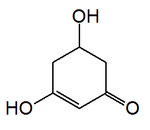Dihydrophloroglucinol
Appearance

| |
| Names | |
|---|---|
| IUPAC name
3,5-Dihydroxycyclohex-2-en-1-one
| |
| Other names
1,3-Dioxo-5-hydroxycyclohexane
| |
| Identifiers | |
3D model (JSmol)
|
|
| ChemSpider | |
PubChem CID
|
|
CompTox Dashboard (EPA)
|
|
| |
| |
| Properties | |
| C6H8O3 | |
| Molar mass | 128.127 g·mol−1 |
Except where otherwise noted, data are given for materials in their standard state (at 25 °C [77 °F], 100 kPa).
| |
Dihydrophloroglucinol is a chemical compound found in the pathway of the microbial degradation of phloroglucinol and other phenolic compounds.[1]
The enzyme phloroglucinol reductase uses dihydrophloroglucinol and NADP+ to produce phloroglucinol, NADPH, and H+. It is found in the bacterium species Eubacterium oxidoreducens.[2]
References
- ^ Armstrong, SM; Patel, TR (1994). "Microbial degradation of phloroglucinol and other polyphenolic compounds". Journal of basic microbiology. 34 (2): 123–35. doi:10.1002/jobm.3620340208. PMID 8014845.
- ^ Haddock, JD; Ferry, JG (1989). "Purification and properties of phloroglucinol reductase from Eubacterium oxidoreducens G-41". The Journal of Biological Chemistry. 264 (8): 4423–7. PMID 2925649.
